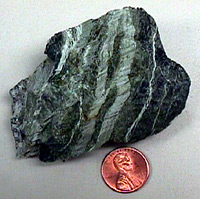Pacific Southwest, Region 9
Serving: Arizona, California, Hawaii, Nevada, Pacific Islands, Tribal Nations
Naturally Occurring Asbestos
Basic Information
National Information

While it is present all over the state of California — in 42 of 58 counties — naturally occurring asbestos can be found most abundantly in and around Humboldt County, in areas of San Benito and Monterey counties, and in western El Dorado county. EPA's Pacific Southwest Region has a long history of involvement in assessing and minimizing the risk from asbestos in California, including Alameda, Calaveras, Fresno, Los Angeles, Santa Clara, Santa Cruz, San Benito, and San Mateo counties.
To view a map of where naturally occurring asbestos can be found in California, visit the California Geological Survey's Report, A General Location Guide for Ultramafic Rocks in California - Areas More Likely to Contain Naturally Occurring Asbestos ![]() .
.
Only a few other areas in the country share a similar occurrence of naturally occurring asbestos with California. They are:
- Fairfax, Virginia

- The state of Washington

- The state of Alaska

Geology of NOA
Asbestos is a term used for a group of silicate minerals that occur as asbestiform fibers. They have high tensile strength, flexibility, and heat and chemical resistance. Asbestos minerals belong to either the serpentine mineral group or the amphibole mineral group. The most common type of asbestos found in California is chrysotile, a serpentine mineral. In fact the California state rock is serpentine, a testament to how common it is to find it in the state's geologic formations. Other types of asbestos include tremolite and actinolite, which are amphibole minerals. Tremolite can occur in a variety of crystal shapes and sometimes occurs as asbestiform fibers.
Toxicology of NOA
The World Health Organization, the federal Department of Health and Human Services, and the U.S. EPA have determined that asbestos is a human carcinogen. Scientists do not yet know with certainty how much exposure to asbestos can result in a person developing asbestos-related disease, but scientists do know that long-term exposure to relatively high concentrations of airborne asbestos is a potent cause of disease. Therefore, it is prudent to reduce environmental exposures whenever possible.
Exposure to asbestos can cause an illness known as asbestosis as well as lung cancer and a rare cancer of the lining of the lungs called mesothelioma. Exposure occurs when asbestos fibers are inhaled, but the effects from exposure are not seen for 20 to 50 years. Cigarette smoke and asbestos together significantly increase the chances of getting lung cancer. Therefore, persons who have been exposed to asbestos should stop smoking. This may be the most important action that individuals can take to improve their health and decrease their risk of cancer.
- Health Effects of Exposure to Asbestos

More information about exposure and the potential illnesses caused by it from the Agency for Toxic Substances Disease Registry's (ATSDR)
Asbestos fibers in rock can become airborne, and therefore a potential health risk, when disturbed. Scientists are still studying how much asbestos in rock or soil becomes airborne when disturbed. In El Dorado Hills, California, U.S. EPA is paving dirt roads and covering bare soil at Oak Ridge High School to prevent naturally occurring asbestos in the soil from becoming airborne, where it can be inhaled. Further, U.S. EPA is planning an assessment to collect information about the number and behavior of asbestos fibers released into the air by activities at public facilities in the area.
| Region 9 NewsroomRegion 9 Programs | Grants & FundingUS-Mexico Border | Media CenterCareers | About Region 9A-Z Index |
